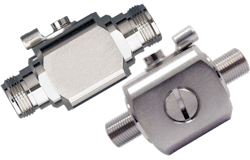Installing a Lightning Surge Protector
for a Cell Signal Booster System

Updated
We strongly recommend that you install and ground a lightning surge protector between your outside antenna and the coax cable running inside to the booster.
These instructions supplement the user manual or installation guide that comes with your cell signal booster.
What a lightning surge protector does—and does not do
A lightning surge protector is designed to protect your cell signal booster from the static discharge of a nearby lightning strike. It will not protect your booster against a direct lightning strike; for that level of protection, we recommend you install both a lightning rod and a lightning surge protector.
Installation instructions
To effectively redirect an electrical discharge, the lightning surge protector must be attached to the outside (donor) antenna on the roof and fitted with a properly grounded copper wire.
Top Signal lightning surge protectors

Top Signal’s 50-ohm (TS450001) and 75-ohm (TS450002) lightning surge protectors have a male connector on one end (threaded inside with a center pin) and female connector on the other end (threaded outside). Attach the components in this sequence:
- Outside donor antenna (female connector)
- Lightning surge protector (male connector to antenna, female connector to coax cable)
- Coax cable to the booster (male connector) and ground wire
Wilson Electronics lightning surge protectors

Wilson Electronics’s 50-ohm (859902) and 75-ohm (859992) lightning surge protectors have female connectors on both ends and require a jumper cable (typically 2 feet of 400-type coax). Attach the components in this sequence:
- Outside donor antenna (female connector)
- Jumper cable (male connectors on both ends)
- Lightning surge protector (female connectors on both ends)
- Coax cable to the booster (male connector) and ground wire
Ground wire
Connect a length of 10-gauge solid copper ground wire to your surge protector to complete the setup. (Do not use braided copper wire.) Purchase the shortest length of wire needed to reach from the lightning surge protector to ground without coils or loops.
Attach the bottom of the ground wire to a properly installed 8-foot copper ground rod. Do not attach the wire to pipes or any other path that leads inside your house or building. (For additional help, see the instructions for installing a ground rod on wikiHow.)
Insert the top end of the ground wire into the lightning surge protector’s eyelet and crimp the eyelet firmly with pliers.
What to do after a lightning strike
If a lightning strike occurs nearby and you suspect that your cell signal booster system has been affected, please call Powerful Signal at 435-634-6800 (M–F, 8:00–4:30 Mountain Time, except major US holidays) or contact us online. We can help you determine if the gas fuse in your lightning surge protector needs to be replaced or if your booster system has been damaged.

